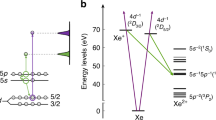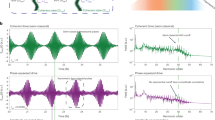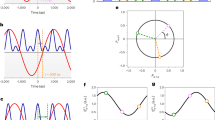Abstract
Light–matter interactions are usually described within the electric-dipole approximation, where the magnetic-field component and the spatial variation of the light electric field over the relevant electronic length scales are both ignored. Non-dipole effects in photoionization were revealed to be tiny from the infrared to the soft X-ray domains, and all non-dipole observations reported so far were limited to single-pulse, single-colour measurements. Here we advance attosecond time-resolved spectroscopy into the non-dipole interaction regime. Using a self-referenced attosecond photoelectron interferometry on helium atoms, we resolve the electron subcycle motion along the light propagation direction in the 15 pm range driven by the magnetic component of a near-infrared laser field. Furthermore, we measure a time delay of 15 ± 10 as between the electric-dipole and electric-quadrupole transitions by resolving the asymmetry of the photoelectron forward–backward yields with attosecond resolution. These fundamental findings are supported by ab initio calculations based on the non-dipole time-dependent Schrödinger equation.
This is a preview of subscription content, access via your institution
Access options
Access Nature and 54 other Nature Portfolio journals
Get Nature+, our best-value online-access subscription
$29.99 / 30 days
cancel any time
Subscribe to this journal
Receive 12 print issues and online access
$209.00 per year
only $17.42 per issue
Buy this article
- Purchase on Springer Link
- Instant access to full article PDF
Prices may be subject to local taxes which are calculated during checkout




Similar content being viewed by others
Data availability
The data generated and analysed in this study are available via the ETH Zurich Research Collection at https://doi.org/10.3929/ethz-b-000638773.
References
Krause, M. O. Photo-ionization of krypton between 300 and 1500 eV. Relative subshell cross sections and angular distributions of photoelectrons. Phys. Rev. 177, 151–157 (1969).
Cooper, J. W. Photoelectron-angular-distribution parameters for rare-gas subshells. Phys. Rev. A 47, 1841–1851 (1993).
Grundmann, S. et al. Observation of photoion backward emission in photoionization of He and N2. Phys. Rev. Lett. 124, 233201 (2020).
Grundmann, S. et al. Zeptosecond birth time delay in molecular photoionization. Science 370, 339–341 (2020).
Amusia, M. & Chernysheva, L. Non-dipole effects in time delay of photoelectrons from atoms, negative ions, and endohedrals. JETP Lett. 112, 673–679 (2020).
Pradhan, G. B. et al. Cooper minima: a window on nondipole photoionization at low energy. J. Phys. B 44, 201001 (2011).
Ilchen, M. et al. Symmetry breakdown of electron emission in extreme ultraviolet photoionization of argon. Nat. Commun. 9, 4659 (2018).
Martin, N. L. et al. Electric-dipole-quadrupole interference of overlapping autoionizing levels in photoelectron energy spectra. Phys. Rev. Lett. 81, 1199–1202 (1998).
Dolmatov, V. K. & Manson, S. T. Enhanced nondipole effects in low energy photoionization. Phys. Rev. Lett. 83, 939–942 (1999).
Lambropoulos, P., Doolen, G. & Rountree, S. P. Electric quadrupole transitions in multiphoton ionization. Phys. Rev. Lett. 34, 636–639 (1975).
Lambropoulos, M., Moody, S. E., Smith, S. J. & Lineberger, W. C. Observation of electric quadrupole transitions in multiphoton ionization. Phys. Rev. Lett. 35, 159–162 (1975).
Reiss, H. R. Limits on tunneling theories of strong-field ionization. Phys. Rev. Lett. 101, 043002 (2008).
Stambulchik, E. & Maron, Y. Zeeman effect induced by intense laser light. Phys. Rev. Lett. 113, 083002 (2014).
Liang, J. et al. Zeeman effect in strong-field ionization. Phys. Rev. A 105, 043112 (2022).
Smeenk, C. T. L. et al. Partitioning of the linear photon momentum in multiphoton ionization. Phys. Rev. Lett. 106, 193002 (2011).
Willenberg, B., Maurer, J., Mayer, B. W. & Keller, U. Sub-cycle time resolution of multi-photon momentum transfer in strong-field ionization. Nat. Commun. 10, 5548 (2019).
Ni, H. C. et al. Theory of subcycle linear momentum transfer in strong-field tunneling ionization. Phys. Rev. Lett. 125, 073202 (2020).
Klaiber, M., Hatsagortsyan, K. Z. & Keitel, C. H. Subcycle time-resolved nondipole dynamics in tunneling ionization. Phys. Rev. A 105, 053107 (2022).
Hartung, A. et al. Magnetic fields alter strong-field ionization. Nat. Phys. 15, 1222–1226 (2019).
Klaiber, M., Yakaboylu, E., Bauke, H., Hatsagortsyan, K. Z. & Keitel, C. H. Under-the-barrier dynamics in laser-induced relativistic tunneling. Phys. Rev. Lett. 110, 153004 (2013).
Liu, J., Xia, Q. Z., Tao, J. F. & Fu, L. B. Coulomb effects in photon-momentum partitioning during atomic ionization by intense linearly polarized light. Phys. Rev. A 87, 041403(R) (2013).
Chelkowski, S., Bandrauk, A. D. & Corkum, P. B. Photon momentum sharing between an electron and an ion in photoionization: from one-photon (photoelectric effect) to multiphoton absorption. Phys. Rev. Lett. 113, 263005 (2014).
He, P. L., Lao, D. & He, F. Strong field theories beyond dipole approximations in nonrelativistic regimes. Phys. Rev. Lett. 118, 163203 (2017).
Ludwig, A. et al. Breakdown of the dipole approximation in strong-field ionization. Phys. Rev. Lett. 113, 243001 (2014).
Maurer, J. et al. Probing the ionization wave packet and recollision dynamics with an elliptically polarized strong laser field in the nondipole regime. Phys. Rev. A 97, 013404 (2018).
Haram, N. et al. Relativistic nondipole effects in strong-field atomic ionization at moderate intensities. Phys. Rev. Lett. 123, 093201 (2019).
Hartung, A. et al. Electric nondipole effect in strong-field ionization. Phys. Rev. Lett. 126, 053202 (2021).
Lin, K. et al. Photoelectron energy peaks shift against the radiation pressure in strong-field ionization. Sci. Adv. 8, eabn7386 (2022).
Reiss, H. R. Relativistic strong-field photoionization. J. Opt. Soc. Am. B 7, 574–586 (1990).
Böning, B., Paufler, W. & Fritzsche, S. Nondipole strong-field approximation for spatially structured laser fields. Phys. Rev. A 99, 053404 (2019).
Brennecke, S. & Lein, M. Nondipole modification of the ac Stark effect in above-threshold ionization. Phys. Rev. A 104, L021104 (2021).
Lund, M. M. & Madsen, L. B. Nondipole photoelectron momentum shifts in strong-field ionization with mid-infrared laser pulses of long duration. J. Phys. B 54, 165602 (2021).
Schultze, M. et al. Delay in photoemission. Science 328, 1658–1662 (2010).
Klünder, K. et al. Probing single-photon ionization on the attosecond time scale. Phys. Rev. Lett. 106, 143002 (2011).
Isinger, M. et al. Photoionization in the time and frequency domain. Science 358, 893–896 (2017).
Gagnon, E. et al. Soft X-ray-driven femtosecond molecular dynamics. Science 317, 1374–1378 (2007).
Huppert, M., Jordan, I., Baykusheva, D., von Conta, A. & Wörner, H. J. Attosecond delays in molecular photoionization. Phys. Rev. Lett. 117, 093001 (2016).
Vos, J. et al. Orientation-dependent stereo wigner time delay and electron localization in a small molecule. Science 360, 1326–1330 (2018).
Cavalieri, A. L. et al. Attosecond spectroscopy in condensed matter. Nature 449, 1029–1032 (2007).
Ghimire, S. et al. Observation of high-order harmonic generation in a bulk crystal. Nat. Phys. 7, 138–141 (2011).
Tao, Z. et al. Direct time-domain observation of attosecond final-state lifetimes in photoemission from solids. Science 353, 62–67 (2016).
Gong, X. et al. Attosecond spectroscopy of size-resolved water clusters. Nature 609, 507–511 (2022).
Jordan, I. et al. Attosecond spectroscopy of liquid water. Science 369, 974–979 (2020).
Dahlström, J. et al. Theory of attosecond delays in laser-assisted photoionization. Chem. Phys. 414, 53–64 (2013).
Dörner, R. et al. Cold target recoil ion momentum spectroscopy: a ‘momentum microscope’ to view atomic collision dynamics. Phys. Rep. 330, 95–192 (2000).
Ullrich, J. et al. Recoil-ion and electron momentum spectroscopy: reaction-microscopes. Rep. Prog. Phys. 66, 1463 (2003).
Kylstra, N. J., Potvliege, R. M. & Joachain, C. J. Photon emission by ions interacting with short intense laser pulses: beyond the dipole approximation. J. Phys. B 34, L55 (2001).
Klaiber, M., Hatsagortsyan, K. Z. & Keitel, C. H. Above-threshold ionization beyond the dipole approximation. Phys. Rev. A 71, 033408 (2005).
Itatani, J. et al. Attosecond streak camera. Phys. Rev. Lett. 88, 173903 (2002).
Krüger, C., Fuchs, J., Cattaneo, L. & Keller, U. Attosecond resolution from free running interferometric measurements. Opt. Express 28, 12862–12871 (2020).
Cireasa, R. et al. Probing molecular chirality on a sub-femtosecond timescale. Nat. Phys. 11, 654–658 (2015).
Baykusheva, D. & Wörner, H. J. Chiral discrimination through bielliptical high-harmonic spectroscopy. Phys. Rev. X 8, 031060 (2018).
Böwering, N. et al. Asymmetry in photoelectron emission from chiral molecules induced by circularly polarized light. Phys. Rev. Lett. 86, 1187–1190 (2001).
Comby, A. et al. Relaxation dynamics in photoexcited chiral molecules studied by time-resolved photoelectron circular dichroism: toward chiral femtochemistry. J. Phys. Chem. Lett. 7, 4514–4519 (2016).
Svoboda, V. et al. Femtosecond photoelectron circular dichroism of chemical reactions. Sci. Adv. 8, eabq2811 (2022).
Han, M., Ji, J.-B., Balčiūnas, T., Ueda, K. & Wörner, H. J. Attosecond circular-dichroism chronoscopy of electron vortices. Nat. Phys. 19, 230–236 (2023).
Brennecke, S. & Lein, M. High-order above-threshold ionization beyond the electric dipole approximation. J. Phys. B 51, 094005 (2018).
Muller, H. G. Numerical simulation of high-order above-threshold-ionization enhancement in argon. Phys. Rev. A 60, 1341 (1999).
Liang, J. et al. Direct visualization of deforming atomic wavefunction in ultraintense high-frequency laser pulses. Ultrafast Sci. 2022, 9842716 (2022).
Liao, Y. et al. Reconstruction of attosecond beating by interference of two-photon transitions on the lithium atom with Rabi oscillations. Phys. Rev. A 105, 063110 (2022).
Acknowledgements
We thank A. Schneider and M. Seiler for their technical support. This work was supported by the National Key Research and Development Program of China (grant no. 2019YFA0308 300), and the National Natural Science Foundation of China (grant nos. 12374264, 12021004, 12074265 and 91950202). M.H. acknowledges the funding from the European Union’s Horizon 2020 research and innovation program under the Marie Skłodowska-Curie grant agreement no. 801459 (FP-RESOMUS). This work was supported by ETH Zürich and the Swiss National Science Foundation through projects 200021_172946 and the NCCR-MUST. The computing work in this paper is supported by the Public Service Platform of High Performance Computing provided by Network and Computing Center of Huazhong University of Science and Technology (HUST).
Author information
Authors and Affiliations
Contributions
Y.Z. and M.H. conceived the study. M.H. performed the experiments with the support of J.-b.J. and C.S.L. The data were analysed and interpreted by J.L., Y.L., Y.Z., M.H., K.U. and H.J.W. Simulations were implemented by J.L. and Y.L., with the help of W.-C.J. This work was supervised by Y.Z., P.L. and H.J.W. The paper was written by J.L., M.H., Y.Z., K.U. and H.J.W., with the input of all co-authors.
Corresponding authors
Ethics declarations
Competing interests
The authors declare no competing interests.
Peer review
Peer review information
Nature Photonics thanks the anonymous reviewers for their contribution to the peer review of this work.
Additional information
Publisher’s note Springer Nature remains neutral with regard to jurisdictional claims in published maps and institutional affiliations.
Extended data
Extended Data Fig. 1 Calibration of IR intensity.
Measured photoelectron spectrum as a function of the time delay between the XUV and IR fields without the attosecond phase stability. The white arrow denotes the maximal energy shift, which is employed to determine the IR peak intensity.
Extended Data Fig. 2 Data analysis.
a Measured photoelectron spectra at θ = 70∘ (blue solid line) and θ = 110∘ (purple line) for helium ionization by the combination of XUV and IR fields. The dashed line represents the fitted background of the photoelectron spectra. b The photoelectron spectra by subtracting the background from the measured spectra. c The comparison of the spectra and the Gaussian fitting of the peaks (green dashed lines). d-f The Gaussian fitting for the photoelectron spectra with the window width of δE = 0.015 (d), δE = 0.02 (e) and δE = 0.025 (f). The vertical dashed lines in c-f mark the peak positions determined by the Gaussian fitting.
Extended Data Fig. 3 Supplementary experimental data.
a-c Measured time-delay averaged photoelectron spectra for photoionization of helium by the combination of the XUV and IR fields at different angles. d-f The same as a-c but at the different time delays for θ = 70∘ (blue solid line) and θ = 110∘ (purple line). The green dashed lines show the Gaussian fitting of the peaks. The vertical dashed lines mark the peak positions determined by the Gaussian fitting.
Extended Data Fig. 4 Measured delay- and angle-resolved photoelectron spectrum.
a Measured delay- and angle-resolved photoelectron spectrum for peak1 (Ek = [10.0, 11.4] eV). b Normalized photoelectron spectrum, \({{{\mathscr{I}}}}(\theta ,\tau ;{E}_{k})={{{\mathscr{M}}}}(\theta ,\tau ;{E}_{k})-\overline{{{{\mathscr{M}}}}}(\theta ;{E}_{k})\), shown in Eq.(6) of the main text. c The asymmetry of the normalized photoelectron spectrum, \({{{\mathscr{I}}}}(\theta ,\tau ;{E}_{k})-{{{\mathscr{I}}}}(\pi -\theta ,\tau ;{E}_{k})\).
Extended Data Fig. 5 Supplementary photoelectron angular distribution and asymmetric distribution.
a Measured delay- and angle-resolved photoelectron spectrum for Ek = [6.7, 8.4] eV. b-d Same as Fig. 4b–d of main text, but for the results of Ek = [6.7, 8.4] eV. e-h Same as a-d, but for the results of Ek = [13.1, 14.8] eV.
Extended Data Fig. 6 TDSE results of the photoelectron energy spectra.
a, Vector potentials of the laser pulses in our calculations. The wavelength and the intensity of the IR field are 800 nm and 5.88 × 1013W/cm2. The centre frequency of XUV pulse is ωXUV=2 a.u., and its intensity is 1 × 1013W/cm2. b c, Photoelectron energy spectra for He ionization obtained by numerically solving TDSE. The blue and red lines are the results for θ = π/4 and θ = 3π/4, respectively. b and c display the results for XUV pulse alone and combination of XUV and IR fields, respectively.
Extended Data Fig. 7 Light-induced electron displacement predicted by nSFA and TDSE.
a Displacement ΔαM(τ) as a function of the time delay between the IR and XUV fields. The intensity and wavelength for the IR field is I = 5.88 × 1013W/cm2 and 800 nm, respectively. The final momentum of the electron is \({p}_{z}=p\sin \theta\) = 1.0 a.u. b The forward-backward momentum shift as a function of the emission angle. c, The forward-backward (θ = 70∘/110∘) momentum shift as a function of the time-delay between the XUV and IR pulses. In b and c the photoelectron energy is 11eV. The solid lines are the prediction from nSFA.
Extended Data Fig. 8 Interference picture.
Schematic representation of the interference between the electric dipole and quadrupole transitions. a The sketch of the PDD and PDQ channels. b The sketch of the PDD and PQD channels. The PDD produces photoelectron with partial waves s and d0. The PQD and PDQ channels produce photoelectrons with partial waves p±1 and f±1. Note that in each channel the transition amplitudes for p1 and p−1 are equal. It is the same for f1 and f−1.
Extended Data Fig. 9 Photoionization time delays.
a CC phase of the electric quadrupole CC transitions. The solid line represents the analytical expression of the CC phase as given in Eq.((33)). The markers represents the results obtained by numerical method. The symbols ‘ × ’ and ‘ + ’ represent the CC phase of electric quadrupole transition for final state with the angular momentum of the final state as l = 1 (p) and l = 3 (f), respectively. b Time delays extracted from the oscillation of the asymmetry parameter by considering different interfering paths, as labelled in the legend. c Times delays extracted from the oscillation of the asymmetry parameters (lines with rhombuses) and photoelectron yield (lines with circles). The solid and dashed lines represent the results from TDSE calculations and obtained by the lowest-order perturbation theory, respectively. d Time delay between the electric-dipole and -quadrupole transitions ΔτQ−D as a function of photoelectron energy. The solid and dashed lines represent the results from TDSE calculations and obtained by the lowest-order perturbation theory, respectively. The symbols with the error bar are the experimental results. The error bar represents the 95% confidence level by the sine fitting.
Rights and permissions
Springer Nature or its licensor (e.g. a society or other partner) holds exclusive rights to this article under a publishing agreement with the author(s) or other rightsholder(s); author self-archiving of the accepted manuscript version of this article is solely governed by the terms of such publishing agreement and applicable law.
About this article
Cite this article
Liang, J., Han, M., Liao, Y. et al. Attosecond-resolved non-dipole photoionization dynamics. Nat. Photon. 18, 311–317 (2024). https://doi.org/10.1038/s41566-023-01349-z
Received:
Accepted:
Published:
Issue Date:
DOI: https://doi.org/10.1038/s41566-023-01349-z



